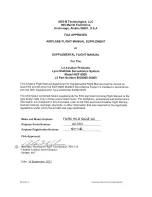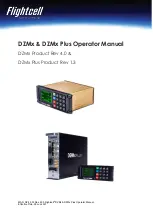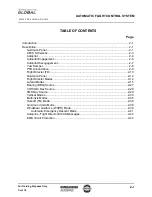
190-00820-11 Rev. A
Pilot’s Guide for the Cirrus SR2x with Cirrus Perspective by Garmin
526
AUTOMATIC FLIGHT CONTROL SYSTEM
SY
STEM
O
VER
VIEW
FLIGHT
INSTRUMENTS
EIS
AUDIO P
ANEL
& CNS
FLIGHT
MANA
GEMENT
HAZARD
AV
OID
ANCE
AFCS
ADDITIONAL FEA
TURES
APPENDICES
INDEX
After manual disengagement, the autopilot disconnect aural alert and the flashing ‘AP’ annunciation may be
cancelled by pushing the
AP DISC
Button.
Automatic autopilot disengagement is indicated by a flashing red and white ‘AP’ annunciation and by
the autopilot disconnect aural alert, which continue until acknowledged by pushing the
AP DISC
Button.
Automatic autopilot disengagement occurs due to:
• System failure
• Invalid sensor data
• Inability to compute default flight director modes
(FD also disengages automatically)
Yaw damper disengagement is indicated by a five-second flashing yellow ‘YD’ annunciation. Automatic
yaw damper disengagement occurs when autopilot disengagement is caused by failure in a parameter also
affecting the yaw damper. This means the yaw damper can remain operational in some cases where the
autopilot automatically disengages. A localized failure in the yaw damper system or invalid sensor data may
also cause yaw damper disengagement.
Figure 7-30 Automatic Autopilot and Yaw Damper Disengagement
REVERSIONARY MODE
In the event of a PFD failure, the MFD goes into reversionary mode. The autopilot remains engaged but
reverts to pitch hold and roll hold modes; all other modes are available for selection. If the MFD fails, the
PFD goes into reversionary mode and the autopilot continues to function.
EXAMPLE FLIGHT PLAN
NOTE:
The following example flight plan and diagrams (not to be used for navigation) in this section are
for instructional purposes only and should be considered not current. Numbered portions of accompanying
diagrams correspond to numbered procedure steps.
This scenario-based set of procedures (based on the example flight plan found in the Flight Management
Section) shows various GFC 700 AFCS modes used during a flight. In this scenario, the aircraft departs Charles
B. Wheeler Downtown Airport (KMKC), enroute to Colorado Springs Airport (KCOS). After departure, the
aircraft climbs to 12,000 ft and airway V4 is intercepted, following ATC vectors.
Airway V4 is flown to Salina VOR (SLN) using VOR navigation, then airway V244 is flown using GPS
Navigation. The ILS approach for runway 35L and LPV (WAAS) approach for runway 35R are shown and a
missed approach is executed.



































